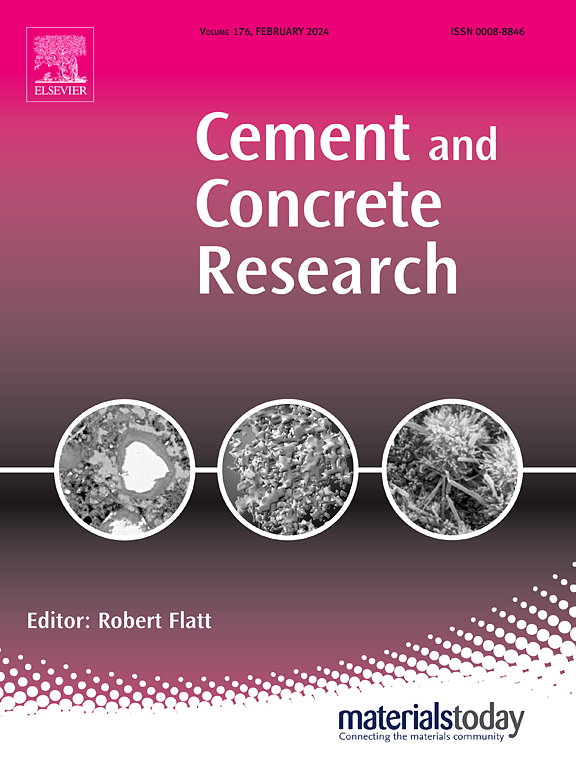了解白石硫铝酸钙水泥的早期水化作用:微量元素和柠檬酸的影响
IF 13.1
1区 工程技术
Q1 CONSTRUCTION & BUILDING TECHNOLOGY
引用次数: 0
摘要
本研究研究了8个组成和物理性质几乎相同的白石型硫铝酸钙(BCSA)水泥批次的早期水化行为,但其水化动力学却存在显著差异。研究人员确定了两种类型的水泥:一种是相对快速凝固的水泥,其最终凝固时间为22分钟,在2小时出现主量热峰;另一种是相对缓慢凝固的水泥,其固化时间为28分钟,在3小时出现峰值。添加柠檬酸可以延缓这些值。由于硫酸钾含量较高,快凝水泥的可溶性钾(149 mM)和硫酸盐(76 mM)的早期浓度高于慢凝水泥(分别为107 mM和57 mM)。较高的碱性含量加速了铝矾石的极限溶解,加速了钙矾石的结晶。等温量热法和现场实验室x射线粉末衍射(通过Rietveld细化分析)证实了溶解和结晶动力学的差异是观察到的变化的基础。柠檬酸的加入使初凝时间和终凝时间均延长了约1.8 h。柠檬酸对硬石膏溶解的延缓作用最为明显,对极限溶解和AFt结晶的影响较小。孔溶液分析表明,柠檬酸增加了钙和硫酸盐浓度,同时降低了钾水平,支持钙络合和柠檬酸盐优先吸附/沉积到无水相的缓凝机制。这些发现强调了早期阶段特定溶解行为在控制BCSA水泥性能中的重要性,特别是对于需要快速凝结和早期强度发展的应用。本文章由计算机程序翻译,如有差异,请以英文原文为准。
Understanding early hydration in belite calcium sulfoaluminate cements: Impacts of minor elements and citric acid
This study investigates the early-age hydration behavior of eight belite calcium sulfoaluminate (BCSA) cement batches with nearly identical compositions and physical properties, yet exhibiting significantly different hydration kinetics. Two clusters were identified: relatively fast-setting cements with a final setting time of 22 min and a main calorimetric peak at 2 h, and relatively slow-setting cements with 28-minute setting times and peaks at 3 h. These values can be retarded by adding citric acid. The fast-setting cements displayed higher early concentrations of soluble potassium (149 mM) and sulfate (76 mM) than slow-setting cements (107 mM and 57 mM, respectively), attributed to greater potassium sulfate content. Higher alkaline content accelerates ye'elimite dissolution and hasten ettringite crystallization. Isothermal calorimetry and in-situ laboratory X-ray powder diffraction (analyzed via Rietveld refinement) confirmed that the differences in dissolution and crystallization kinetics underlie the observed variability. The addition of citric acid extended both initial and final setting times by approximately 1.8 h. Its retarding effect was most pronounced for anhydrite dissolution, with a smaller impact on ye'elimite dissolution and AFt crystallization. Pore solution analysis revealed that citric acid increased calcium and sulfate concentrations while reducing potassium levels, supporting a retardation mechanism involving calcium complexation and preferential sorption/deposition of citrate onto anhydrous phases. These findings underscore the importance of early-age phase-specific dissolution behavior in governing BCSA cement performance, particularly for applications requiring rapid setting and early strength development.
求助全文
通过发布文献求助,成功后即可免费获取论文全文。
去求助
来源期刊

Cement and Concrete Research
工程技术-材料科学:综合
CiteScore
20.90
自引率
12.30%
发文量
318
审稿时长
53 days
期刊介绍:
Cement and Concrete Research is dedicated to publishing top-notch research on the materials science and engineering of cement, cement composites, mortars, concrete, and related materials incorporating cement or other mineral binders. The journal prioritizes reporting significant findings in research on the properties and performance of cementitious materials. It also covers novel experimental techniques, the latest analytical and modeling methods, examination and diagnosis of actual cement and concrete structures, and the exploration of potential improvements in materials.
 求助内容:
求助内容: 应助结果提醒方式:
应助结果提醒方式:


